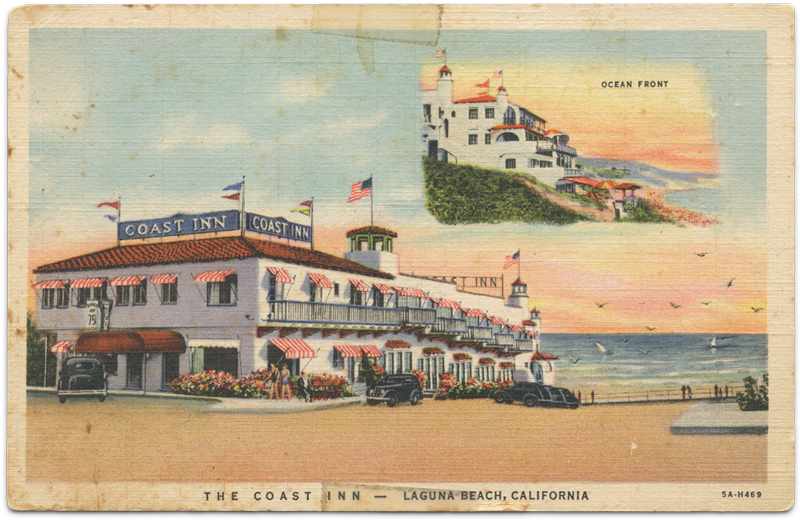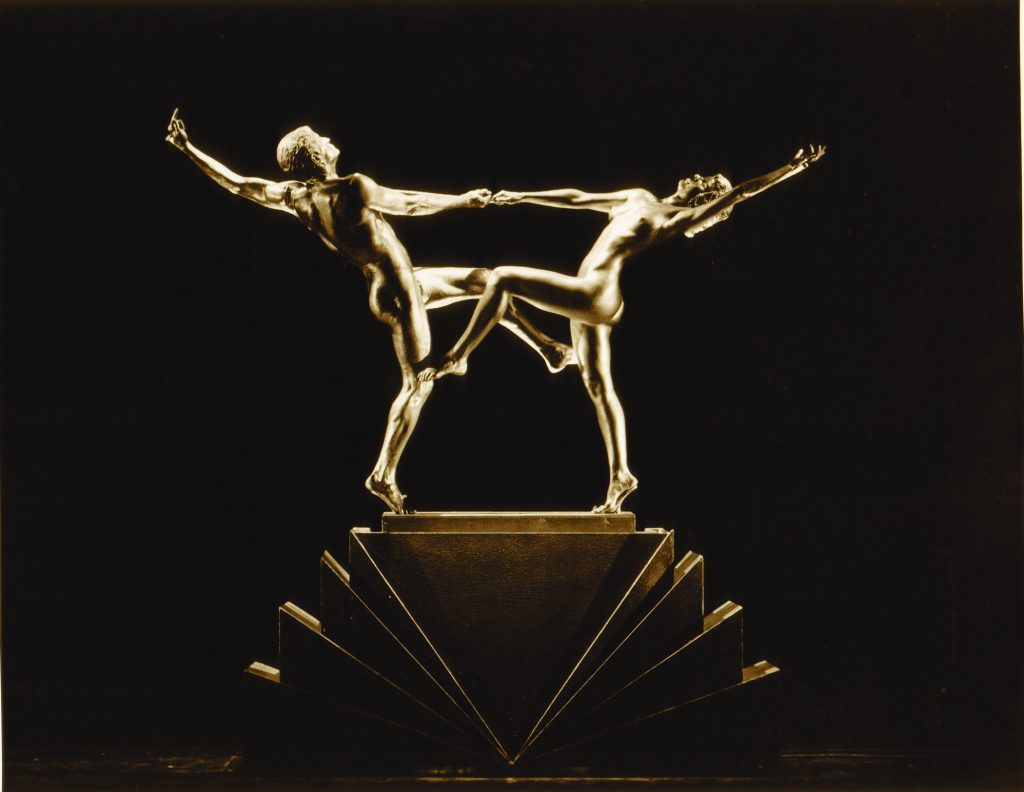Back in the 1980s I was given tickets to a Southern California kitsch institution, Pageant of the Masters. The concept intrigued: an amphitheater stage filled with “ninety minutes of tableaux vivants (living pictures), incredibly faithful recreations of classical and contemporary works of art, with real people posing to look exactly like their counterparts in the original pieces,” as described on the event website. But the execution, meticulous as it was, underwhelmed. I guess I wanted more vivants in the tableaux, which occurred too infrequently. But it did occur in a sort of sideshow.
That sideshow was not the companion Fine Art Show, which we took in before the Pageant and from which Andrea and I bought a couple of hand-altered Polaroids that hang on our walls today. Allow me to digress…
Boom Boom Room
The Fine Art Show was conspicuous by the omission of skin: many of the artists appeared to be too well constrained by a bland family-friendly bubble-wrap envelope, but not so well contained that we couldn’t detect hints of riskier work. Hell, Laguna Beach (the Pageant/Show’s site) was home to the Boom Boom Room, which OC Weekly (formerly a sibling to Denver’s Westword via Voice Media Group) claims to have been “the oldest gay bar in the Western United States,” its host hotel, the Coast Inn, having opened in 1929, per the founders’ granddaughter’s timeline. Laguna even had its own chapter of the Mattachine Society beginning in the ’50s.

A Boom Boom Room preservation website archive states that, at the time of our visit in the ’80s, Laguna was estimated (how?) to have a gay population of nearly a third and had an openly gay mayor, Bob Gentry, by 1989. As a city council member, in 1983 Gentry became “Southern California’s only openly gay elected official,” according to the Los Angeles Times. That same year Gentry buried his partner Gary Burdick after being denied time off to care for him because—Mayor or not—he wasn’t a family member.
</ digression>
The sideshow to Pageant of the Masters of which I speak consisted of at least one between-scenes vignette in the form of gorgeous living statues positioned beside the amphitheater’s aisles. These were simple, yet elegant, and could not help but reveal their human form. I don’t pretend to know the history of the tableau vivant, but per its Wikipedia entry, censorship on the stage, whereby a naked woman was prohibited to move, caused necessity to birth a new invention: poses plastiques. These latter-day examples took us by surprise that night and took us back to that other time. We couldn’t tell where the pose left off and the person began.

Low Tech
Like a drag artist doffing his wig, the Pageant players could tend to move once the illusion was fixed in the eye. And of this I was reminded, a couple of years later, when I picked up the laser disc (!) collection of promo videos for nine out of ten tracks from the R.E.M. album Out of Time (1991). The video for the song “Low” is by James Herbert, who until 2006 taught painting and filmmaking at the University of Georgia and with whom the band’s lead singer Michael Stipe studied. Herbert himself studied with painter Clyfford Still and at the University of Colorado with filmmaker Stan Brakhage. (Friend and acquaintance and musician Tom Recchion did the the graphic layout for Out of Time and other R.E.M. albums as well as Good Stuff for the B-52’s, discussed below.)
In contrast to that Laguna Fine Arts Show, Herbert declares that his work “is known for its obsession with the nude figure in romantic and erotic figurations with an emphasis on the role of sexuality and scene context.” But such sensuality in “Low” is only flirted before being flaunted, by: Stipe’s own torso, a nude astride a horse, the figures on the floor of the imagined artist’s atelier (header image for this post). Herbert crafted “Low” from several paintings held by the Georgia Museum of Art. The main tableau is La Confidence (ca. 1880) by Elizabeth Jane Gardner, which this week left its home for Bob Jones University in Greenville, South Carolina. The painting is on (virtual) loan in “Low” as well, transported from gallery wall to virtual verdancy as monastics pass its cemetery setting, viewing and then averting.
Herbert’s vivant modus is more Clutch Cargo than Industrial Light & Magic. I’m thinking of the Syncro-Vox technique of a static image with superimposed talking lips. His effects in the tableaux are lovingly imperfect, and sometimes we’re looking over the shoulder of the filmmaker at the Moviola (as in the video’s introductory sequence). Lines between the artificial canvas and filmed artificiality are blurred and erased. The water jug actually is tipped, the blouse drawstring tugged, the posy-ed letter dropped, the confidence actually delivered.
But much of the time the confidante’s gaze is obscured in shadow; Herbert doesn’t really allow us to meet it even when moving from eye to eye. Via the Gardner painting the gaze is direct, knowing, and just this side of brazen. Perhaps unwittingly Herbert succeeds in separating the confidante from the confider, just as Gardner has done. He does so through filmic superimposition. But look: Gardner’s shawl-draped confider is almost superimposed as well. Her lips are not in shadow—she’s nowhere near the ear of the confidante—just as her fingers have yet to alight. Is she even real? A question that can be posed regarding any work of art.
Revolution Earth
Yesterday I stumbled across another promo video that seemed to have Herbert’s mark, and I was correct. It’s for another band from Athens, Georgia, The B-52’s. Superimposition is used in a more conventional way, but again Herbert’s mattes are anything but seamless. Rather than via an arousing intimacy, the spectacle still stirs the listener to reconcile the view.
In “Revolution Earth,” from the album Good Stuff, a sedan wheels off a pier into the briny deep from which emerge two black-clad figures that seemingly soar above the surface. The ship of state(s) is hauled by servile lamé-loincloth-clad youths through a shabby, scaffolded street, with vocalist Kate Pierson standing in for the vessel’s figurehead, Keith Strickland its navigator, and Fred Schneider the pilot. The darlings (from the lyrics) lying beside each other are newly liberated Belarusian Olympic gymnastic champions Svetlana Boginskaya and Vitaly Scherbo who had just completed the 1992 games. Zebras in the wild and in the street compete with said darlings and with soldiers and would-be revolutionaries, one of whom lays down arms to join the parade. Day turns to night (earth’s revolution) and the footlight-lit procession is crowned with the “gliding fireworks” of explosives, the rebels’ stock-in-trade. The ship is pulled from the city to the savannah to the gravel plain as the gymnasts, suspended from the revolving mast, plunge into the sea and sedan. Full circle.
A quarter century hence, with climate chaos in full flower, “Revolution Earth” is fulsome in nuance.

